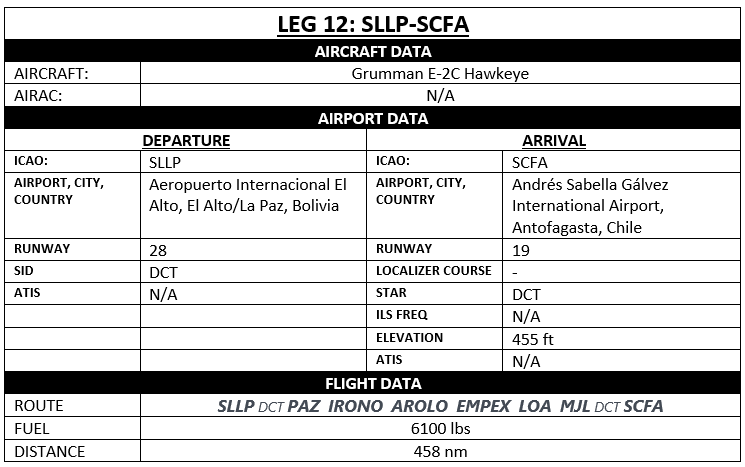Twelfth entry for the Christmas Challenge.
Click to reveal AAR
Spawning in the Grumman E-2C Hawkeye by Indiafoxtecho.
This variant doesn’t have the EFIS upgrades, so the cockpit is mostly analog. In the package provided by Indiafoxtecho (also known as Dino Cattaneo), the C-2 Greyhound and E-2 Hawkeye are both available in EFIS and non-EFIS variants.
First, you need to make sure your battery power is on and the DC BUS TIE is on as well.
Then, the MFCDU switches need to be on as well.
The MFCDU (Multi-Function Control Display Unit) looks like an interesting beast. You can input waypoint coordinates manually (which I did).
The NAV menu. Press LSK next to RTN to return to the main menu (or press the U CAT button on the keypad, which goes to the MAIN CATEGORY menu).
Go in DATA
Go in WAYPOINT
Click on ADD
Press on LSK next to LAT, then press N or S to select latitude, then enter your latitude coordinates on the keypad.
Then, press ENT to enter coordinates. Repeat for Longitude field (don’t forget to add a “0” before),
Once the coordinates are entered, set waypoint altitude in the same way (in meters, so for 26000 ft cruise altitude we set 07924 meters). Then,click on LSK next to “ADD WP” and voila. You’ve got a new waypoint.
Engine start procedure is fairly simple
- Condition Levers - RUN
- Power Levers - START
- Tank Interconnect Switch - CLOSED
- Fuel Boost Pumps - ON
- Autofeather Switch - ARMED
- L and R GEN Switches - ON
- ENG START Switch - R (to start right engine)
Good engine start. Notice the low RPM since the LOW SPEED GROUND IDLE switches are ON. At an RPM this low, the generators haven’t kicked in yet. In order to do that, I need to set the LOW SPD GND IDLE switches (LSGI) OFF.
I release the parking brake, then start taxiing.
Cloud cover is at 1500 ft AGL
Ready for takeoff
Setting MAX RUDDER switch to 20 deg for takeoff.
LSGI switches OFF, rotation speed is at 120 kts, initial climb speed is 165 kts (reducing by 1 knot/1000 ft altitude. Good to go.
Rotate!
As I accelerate beyond 140 kts, I set the MAX RUDDER switch to 6-2 deg.
Turning towards our first waypoint: IRONO.
A bit windy, but we manage to stay on course
The weather isn’t particularly interesting. Minor turbulence but nothing the Hawkeye can’t handle.
More terrible weather ahead
That’s definitely one sweet-looking plane. If it ever came to DCS, I’d buy that in a heartbeat.
Approaching Río Desaguadero (Aullagas or Chacamarca during the pre-columbian era) just before hitting Lago Uru Uru.
Volcanoes Tunupa and Carabaya in the distance
The MFCDU has interesting functionalities to monitor throughout the flight.
The CALC (Calculation) Menu has an ETA (Estimated Time of Arrival), Fuel and DUR/RNG (Duration/Range) page.
The HSI (Horizontal Situation Indicator) menu has the HSI and the PPS (Present Position) page.
The A/C (Aircraft) page displays interesting parameters as well.
The clouds slowly fade away. Seems like the weather suddenly dried up.
Looks like we’re just about to fly over the last mountains before the salt lakes.
Vila Pucarani, a volcano located in the Coipasa salt pan, a part of the Bolivian Altiplano.
Uyuni Salt Lakes in the distance
Cerro Cañapa, an elongated mountain in Bolivia close to the border with Chile. The mountain forms an enormous backdrop to the colorful lakes Cañapa and Hedionda.
Laguna Hedionda is notable for various migratory species of pink and white flamingos.
The second-to-last turn before Andrés Sabella Gálvez, formerly known as the Cerro Moreno airport.
Consulting SFCA METAR report and adjusting my barometric setting.
Visibility is really poor during the initial descent
Running on fumes
Finally made it out of the mountains
The Pacific Ocean. Now I just need to follow the coast until I get to Antofagasta.
For the approach, I basically need an ON SPEED AOA (yellow donut) with flaps 30 and throttles at about 850 SHP. Landing gear is retracted below 190 kts. I also have to set my MAX RUDDER switch to 30 deg when below 140 kts.
Runway spotted
A bit long on final
Touchdown
Vacating runway
Taxiing
500 lbs of fuel left. By navy standards, that’s doing it waaaay too safe. ![]()
Wow… these Allison T56-A-425 turboprop engines are really unkillable. They went through complete opposite extremes in terms of temperature and humidity levels and still got the job done.
Overall, my impressions in the E-2: it’s an aircraft that feels cramped but you sort of feel safe inside the cockpit.
I gotta say… that was a fun experience in the E-2.

































































